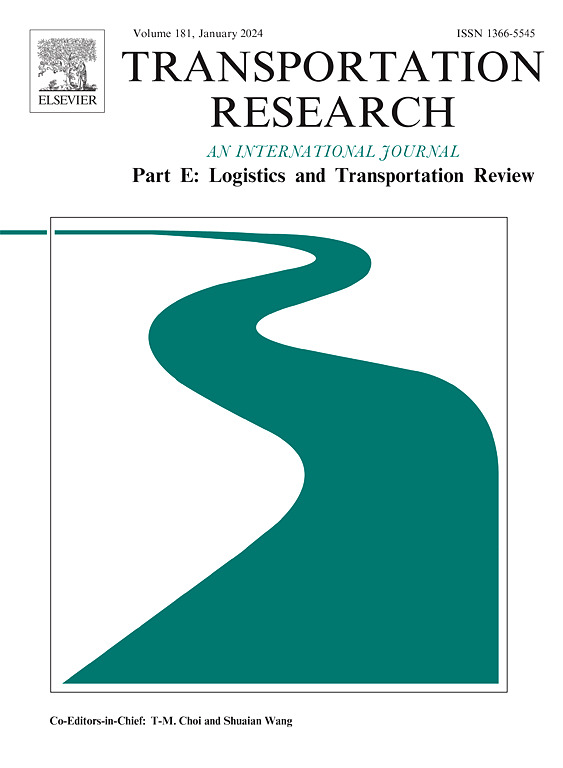用车辆和无人机优化当日送达:一种分层深度强化学习方法
IF 8.3
1区 工程技术
Q1 ECONOMICS
Transportation Research Part E-Logistics and Transportation Review
Pub Date : 2024-11-28
DOI:10.1016/j.tre.2024.103878
引用次数: 0
摘要
由于顾客对快速运输的期望不断提高,以及市场竞争力的需要,当日达服务的出现受到了极大的欢迎。为了优化此类服务,使用车辆和无人机的异构车队已被证明可以有效减少交付所需的资源需求。本文主要研究由多辆车辆和无人机组成的车队的当日送达调度和路线问题。在这个问题中,随机和动态的请求,加上严格的时间限制,要求调度员做出实时决策,以最佳地分配车辆和无人机,在考虑路线的同时确保交付操作的效率和有效性。为了解决这个复杂的问题,我们使用基于路线的马尔可夫决策过程对其进行建模,并开发了一种基于深度强化学习(HDDRL)的新型分层决策方法。层次结构的第一级的任务是确定车辆的出发时间,平衡交付频率和效率之间的权衡。层次结构的第二层致力于为每个请求确定最合适的交付模式,无论是通过车辆还是无人机。第三层负责车辆和无人机的路线规划,从而提高路线效率。分层框架中的这三个层次协作以同步的方式解决问题,目标是在一天内最大化服务请求。计算实验的经验结果突出了HDDRL优于基准方法的优势,不仅证明了它的有效性增强,而且在不同数据分布和车队规模下具有鲁棒泛化能力。这凸显了HDDRL作为提高当日送达服务运营效率的有力工具的潜力。本文章由计算机程序翻译,如有差异,请以英文原文为准。
Optimizing same-day delivery with vehicles and drones: A hierarchical deep reinforcement learning approach
The advent of same-day delivery services has achieved immense popularity, driven by escalating customer expectations on fast shipping and the need for market competitiveness. To optimize such services, the use of heterogeneous fleets with vehicles and drones has proven effective in reducing the resource requirements needed for delivery. This paper focuses on investigating the same-day delivery dispatching and routing problem with a fleet of multiple vehicles and drones. In this problem, stochastic and dynamic requests, coupled with their stringent time constraints, require dispatchers to make real-time decisions about optimally assigning vehicles and drones, ensuring both efficiency and effectiveness in delivery operations while taking into account the routing. To tackle this complex problem, we model it with a route-based Markov decision process and develop a novel hierarchical decision approach based on deep reinforcement learning (HDDRL). The first level of the hierarchy is tasked with determining the departure times of vehicles, balancing the trade-offs between the delivery frequency and efficiency. The second level of the hierarchy is dedicated to determining the most suitable delivery mode for each request, whether by vehicles or drones. The third level is responsible for planning routes for vehicles and drones, thereby enhancing route efficiency. These three levels in the hierarchical framework collaborate to solve the problem in a synchronized manner, with the objective of maximizing the service requests within a day. Empirical results from computational experiments highlight the superiority of the HDDRL over benchmark methods, demonstrating not only its enhanced efficacy but also its robust generalization across diverse data distributions and fleet sizes. This underscores the HDDRL’s potential as a powerful tool for enhancing operational efficiency in same-day delivery services.
求助全文
通过发布文献求助,成功后即可免费获取论文全文。
去求助
来源期刊
CiteScore
16.20
自引率
16.00%
发文量
285
审稿时长
62 days
期刊介绍:
Transportation Research Part E: Logistics and Transportation Review is a reputable journal that publishes high-quality articles covering a wide range of topics in the field of logistics and transportation research. The journal welcomes submissions on various subjects, including transport economics, transport infrastructure and investment appraisal, evaluation of public policies related to transportation, empirical and analytical studies of logistics management practices and performance, logistics and operations models, and logistics and supply chain management.
Part E aims to provide informative and well-researched articles that contribute to the understanding and advancement of the field. The content of the journal is complementary to other prestigious journals in transportation research, such as Transportation Research Part A: Policy and Practice, Part B: Methodological, Part C: Emerging Technologies, Part D: Transport and Environment, and Part F: Traffic Psychology and Behaviour. Together, these journals form a comprehensive and cohesive reference for current research in transportation science.

 求助内容:
求助内容: 应助结果提醒方式:
应助结果提醒方式:


